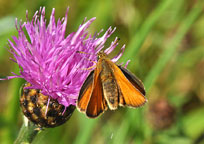The Essex Skipper is very similar to the Small Skipper. Those with solid
black tips to the antennae are Essex Skippers, those with small oval orange to dark brown areas under the tips of the antennae are Small Skippers.
It is not always very easy to see that a Small Skipper with mostly dark brown to dull black antenna tip patches is not an Essex Skipper.
The tip of the antenna of the Essex Skipper is more rounded and club shaped, in the Small Skipper it is more curved and slightly pointed.
The male wing stripe is generally broader and more diagonal on the Small Skipper, though the degree of difference in published illustrations is not always very distinct. The black wing borders are often more clearly defined in the Small Skipper, in the Essex Skipper they tend to blend in more gradually.
The tips of the undersides of the fore wings are tinted orange in the male Essex Skipper, and gray-buff in the female Essex Skipper and the Small Skipper, though this is difficult to confirm in the field.
There is only one brood per year. The principal food plant given is Cocksfoot, though other grasses are mentioned. Essex Skippers overwinter as eggs layed in the flowering stems of the grasses - so it is important not to cut long grass where it can be avoided. On my small meadow I control the spread of unwanted tree seedlings and runners and limit the size of the bramble bushes by hand as and when necessary and never cut the grass.
The eggs hatch in spring to become larvae feeding on the same grasses for a few weeks, before pupating and then emerging as adults in mid summer. Most are seen on the wing in July.




